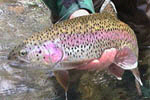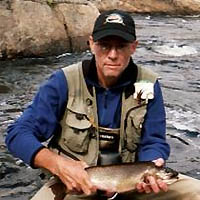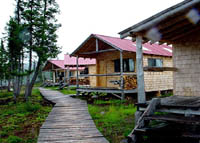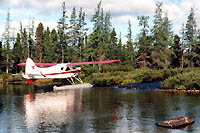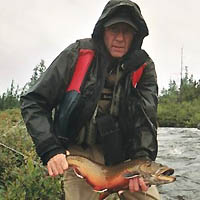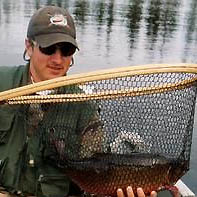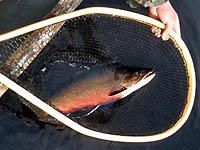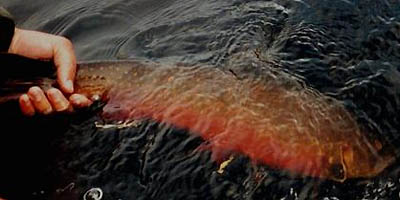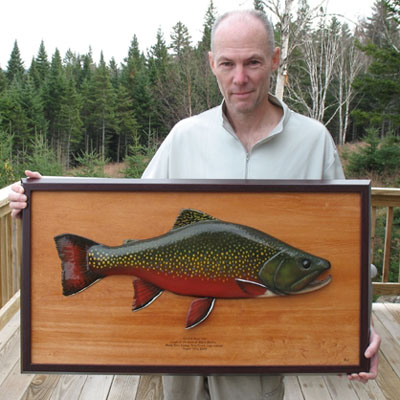|
Flies With a Story #58: This is Bob Erickson's second story in fishingwithflies.com
|
Story and Flies by Bob Erickson of Huntington, Vermont |
| Bob works for the Defense Department and lives in Vermont with his wife and son and a chocolate lab named Baxter. Bob finds plenty of time for fishing and exploring, especially in Maine. Home of some great trout and salmon fishing, he is in the process of building a camp in Rangeley, Maine. |
|
See Bob's other
Flies With a Story: |
|
Labrador: Big Patterns for Big Brook Trout |
|||||||||
Over many seasons of fly fishing in Maine, the native brook trout has become the species I am truly passionate about. It my mind there is not a more beautiful fish in the world. The colors of a pre-spawn male defy description. Salvelinus fontinalis, “char, living in spring”, has come to embody all the grandeur that I associate with the far “North” and I had long dreamed of a trip to the ultimate destination to fish for them, the Labrador wilderness. It is the last place on earth where you can still fish for brook trout of unimaginable size. Advancing age and a recent up-close and personal encounter with cancer added up to tell me it was time to go. Life is short and you only live once.
There are many outfitters to choose from, but after a lot of web site reading and viewing (all of the photo galleries look amazing), e-mailing and visiting shows, I decided on Robin and Chris Reeves’ Three Rivers Lodge located on Crossroads Lake and the headwaters of the one hundred mile Woods River drainage. (Their Web site is www.trophetlabrador.com.) One quality that distinguishes Three Rivers from others is their fly fishing only, barbless hook and strict catch and release policy. It is clear that the protection of the unique brook trout population and the pristine ecosystem that supports it is placed above all else. Chris wrote; “Our goal from the opening day was absolute minimal impact on the fishery and let nature take care of the rest. During our first couple of years, some of our guides were driven close to tears by the act of releasing a big fish. Now they see it working and understand the benefit.” Chris went on to explain that if the largest trout are killed for trophies, as other lodges allow, or even encourage, over time the genetic line is weakened, never to return. I was planning on going in 2005, but when Robin called with an unexpected opening this past August, I jumped on it. The dream was about to come true.
The real adventure began with the 150 mile flight from Wabash to the camps in a 1947 DeHavilland Beaver. The flying was to become a highlight of the trip. It’s an extraordinary and relatively quick way to “commute” to the fishing and back. It allows access to water that otherwise might take days to reach. Within ten minutes flying time outside of Wabush, all sign of civilization vanished, down below was a world of blue and green. An untouched wilderness stretched to the horizon that appeared to be at least 75% water; a myriad of shimmering lakes and ponds feed by numerous small streams and separated by short stretches of rapids. Only a small percentage of that water has yet to be fished! The land is low and rolling, it has the raw, rugged look of recent glaciation. Where there is enough soil, stunted black spruce grow. Everywhere is a seemingly random maze of caribou trails; Crossroads Lake is named for the bands of the George River herd of Quebec-Labrador caribou that congregate on its shores every August and September, waiting to ford or swim during migration. The entire Three Rivers staff was there to greet us as we taxied up to the dock. They quickly came to be some the warmest, open and caring people I’ve ever met. It feels like being adopted into a big, happy family. The “Newfie” guides, Jordan and Cliff, were especially fun to be with and sharing the water with them soon felt like fishing with good friends. The “guiding” was minimal. If you appeared to know what you were doing they pretty much left you on your own. However, once you hooked a fish, it was amazing how quickly they could cover the rough terrain and be ready with the net. And the nets are huge, a good indication of what was to come.
It took some time for me to adapt to the fishing. This was a far cry from making delicate presentations to finicky trout sipping spinners at the tail out of a placid pool. The first thing that took getting used to was casting big, very heavily weighted flies, Cone Head Muddlers, Clouser Minnows and of course Woolly Buggers. I never did get over the instinct to duck as those 3 to 5 inch flies came whistling past my ear. The hatches were over and these fish were looking for a substantial chunk of meat to bulk up on before the fast approaching winter. It is not unusual for them to put on 1½ to 2 pounds per season! The water was full of baitfish which Jordan and Cliff called “sucker minnows”. The trout were satiated and reluctant to feed further. They would chase the flies, but weren’t real aggressive on the take, lots of short strikes and outright refusals. The only pattern I ended up fishing on top was a lemming. It turned out to be a good “locator”; the trout would almost always at least come up and take a look at it. For the subsurface flies, a warp speed cross-current or even downstream strip turned out to be the most effective tactic. Add the heavy water (rapids, boulders, plunge pools, pockets and undercut banks) that brook trout stack up in and it took some time to become at ease with what it takes to fish and wade the water. The slower water above and below the rapids, which back in Maine would look like perfect trout holding habitat, was indeed ideal pike territory. It took a lot of flies lost to those big, sharp teeth to convince me not to fish there. On the other hand, the pike (and lake trout, eagle and osprey) predation is a large part of what keeps the trout population healthy, big and strong.
On the second day, Jordan and I were flown to the 5th Rapids outpost camp for an overnight. It is a particularly picturesque spot sitting high on an esker, surrounded on either side by “Big” and “Little” 5th rapids (the rapids are numbered in sequence down river from Crossroads Lake). It was here that it all came together, and I was able to land two of the Labrador “reds” I had traveled all this way for. Jordan estimated them both at 8 pounds. To my inexperienced eye, they looked and felt a lot larger and heavier than that! The second trout came from Little 5th. I watched him rise from the depths and, in what seemed to be slow motion, inhale the lemming pattern I was bouncing across the surface. Wow. But the best was yet to come. A couple of days later, Jordan and I motored down to Vezina narrows, another set of rapids separating Crossroads Lake from the channel leading to 1st Rapids. Here we found several 6+ pound trout holding in some calmer water against an alder lined bank. With Jordan spotting, we tried sight fishing for them from above and got two of them to take, but missed them both. I was too quick to strike. Several more pattern changes met without as much as a look. I waded out to an exposed rock, where I was able to cast back into the bank. I finally hooked one of the trout on a Black Ghost Clouser as it swung back into the current. I lost that fish in the heavy water also. It was raining lightly with no wind and the black flies were the worst they had been all week. It felt like time to try something different. The two other clients in camp, a father and son from North Carolina, had shot the caribou they had come to hunt and since then had been doing very well catching big pike and lake trout on spin gear out on the Lake. I asked Jordan if we could give the lakers a try on the fly, he suggested a sheltered cove opposite the main camps at the outlet of a small stream named Sophia. We anchored off the mouth of the stream and it didn’t take long to hook and land an outstanding fish. To Jordan’s surprise it was a brook trout; he said none had ever been caught there before. What surprised both of us was its size and weight, we figured over 7 pounds! Its amazing how one fish can turn your day around, suddenly everything felt right again, the mornings tough fishing a fading memory. We fished the rest of the cove with no luck. About to call it day, I asked if we could try the stream outlet one more time. Staring into the big streamer box, I chose a Mickey Finn Clouser that had been tied by a good friend for the trip. It was kind of a joke between us. Is there is anything in nature that a yellow/red/yellow streamer could possibly imitate? Even though it’s a classic brook trout pattern, I’ve never had much confidence in it, but it was one of those “why not?” moments. The second cast brought a solid strike, the fly felt like it hung on the bottom. Then rod doubled over and line peeled off the reel. It didn’t feel like a pike, they usually cut through the leader in a heartbeat, but I thought surely it must be a large laker. After the initial run, I was able to work the fish close enough for Jordan to get a look at it. He exclaimed it was by far the biggest brook trout he had ever seen. It was the first time all week I had seen a crack in his usual cool, calm demeanor which got my heart pounding. The first two attempts with the net failed. With each miss the fish would make another powerful run, ending in bulldog-like head shaking. Fortunately the trout was well hooked, the tippet held and by the third try he was in. Jordan held the net as I, with trembling hands, removed the fly from the heavily kyped jaw. One of dumbbell eyes was missing, probably from the fish rubbing his jaw on the bottom in an attempt to free itself. Here was a lasting reminder of just how strong these fish are. The even brighter than normal colors that set the Labrador strain apart were manifest in this trout; intense orange in the belly; vivid red, with a leading edge of milk white, then black, in the tail and lower fins.
I had found the size of the 5th Rapids trout hard to comprehend, but this one was another order of magnitude beyond those. It was the depth of this fish that really stood out. There was a prominent hump in the shoulders and Jordan measured the girth at 18”! That dimension alone would come close to a trophy Maine fish. The length was 26 ½”, the two measurements calculated to 10.7 lbs on the chart, second only to an 11.5 lb world fly rod record trout caught the previous season at 2nd Rapids.
After a few quick shots, Jordan eased the fish out the net, worked him back and forth in the water and released it when a flip of its massive tail signaled it seemed ready to go. After the trout had slowly disappeared, we both sat back down, staring at each other with ear to ear grins. There was nothing to say for a good long while. I’m not sure which one of us was happier. The well worn cliché of “fish of a lifetime” seemed fitting; it was hard to imagine the experience could get any better.
With one more day to go, I could relax and let it all soak in. That morning we flew to the headwaters of Rick’s Run, a small, user-friendly stream that you could literally spit across. We were only the sixth party to fish it. Almost immediately, I began to catch 10 to 12” trout. Behind every boulder where you thought a trout should be there was one or two and they were all over the woolly bugger I was fishing. The fish weren’t fussy; it was a welcome change from the hard work I’d put in so far. It reminded me of a really fine day of fishing in Maine and it felt great. As I worked my way downstream, the fish became larger, up to 16”. Maybe I was still in Labrador after all? The final run deepened considerably and the perfect lie appeared to be under the alders on the opposite bank. I took a chance, flipped a cast into the one opening in the brush and got lucky. As soon as the fly hit the water, the fish struck, fought hard and was much larger than I could have imagined in such small water. Cliff was upstream with the net, but I managed to lead the fish into calmer water and lip the trout just as he appeared for a photo, yet another hook jawed, perfectly proportioned 6+ lb beauty. We still had the afternoon to fish, but for me there was no better way to top off the week. It seemed like the perfect moment to pause and reflect. Sitting on the Beaver float in the sun, legs dangling in the water, enough of breeze to keep the bugs down and eating lunch with Cliff, I remembered Robin telling me that I would leave Labrador with my most cherished memory being the people, the wilderness and the brook trout following. I wouldn’t have believed him before the trip, but he was exactly right. The Three Rivers Web site closes with this quote: “Along the rivers, streams and ragged hills there is magic to be found, Labrador stays with you.” How true. I can’t wait to return. -- Bob Erickson Note: Because of the last minute decision to accept Robin’s offer, I didn’t have the time to tie up all the flies I thought I needed before the trip. Fortunately Dave Lutton, the person who taught me to tie, was able to help fill in the gaps. From the list of recommended patterns that Three Rivers provides, Robin advised me to concentrate on large streamers and he was right.
Addendum!
|
|
copyright © Notice by fishingwithflies.com. All rights reserved. This material is for your personal enjoyment. Please obtain prior written permission from the author and fishingwithflies.com before any other use. |
